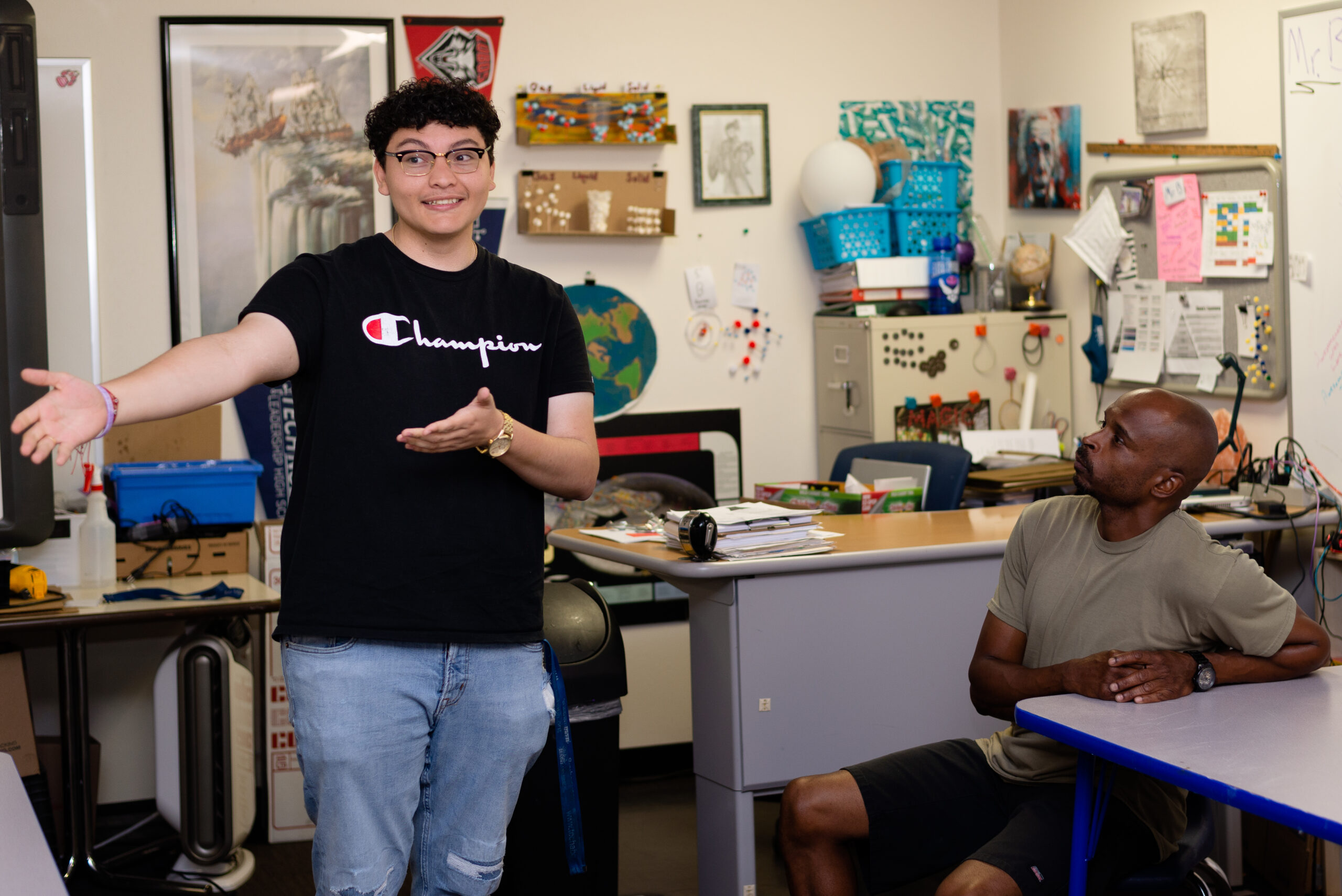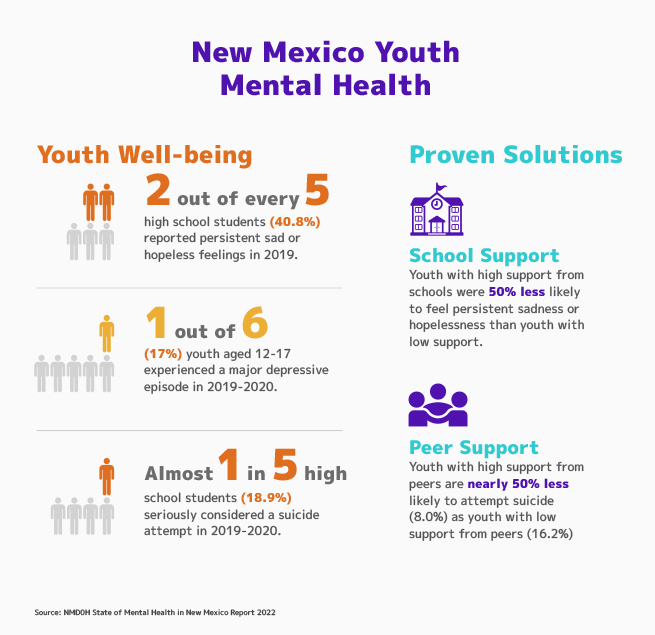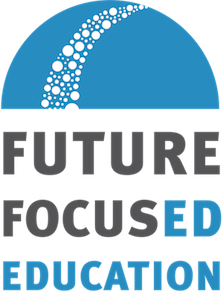Students as Mental Health Responders: Answering the Call for More Youth Mental Health Support

We have to find ways to care for the whole person, says Licensed Clinical Social Worker (LCSW) Ali Moore. Otherwise, students won’t be able to learn.
“What we know about learning is that if our mental health isn’t cared for, the part of our brain that is responsible for deeper learning—the place we want most online in a classroom—is not going to be able to operate fully,” says Moore, who is Future Focused Education’s Director of Social Emotional Learning and Well-being.
Fortunately, many schools are working to incorporate mental health support in their curriculum, especially in New Mexico. Many districts have already built social and emotional learning practices into their curriculum, but more recently, they have tried new approaches. In 2021, Future Focused received a grant from the Department of Health to support four charter schools in Albuquerque that made up the Leadership Schools Network (LSN). The purpose of the grant was to train school and organizational staff in Youth Mental Health First Aid and to become Teen Mental Health First Aid Sites.
Mental Health First Aid (MHFA) courses were started by the National Council for Mental Wellbeing and are modeled after regular First Aid courses; the goal is to increase everyone’s ability to address basic mental health concerns (when an expert isn’t present) and to serve as a bridge to getting appropriate professional help during a crisis. This allows communities to grow our collective capacity to prevent crises from occurring instead of immediately sending people who need support away, bottlenecking our already limited number of providers.
The grant supported the integration of paid X3 Youth Mental Health and Peer Support Internships at the school to bolster peer support and youth-driven strategies and initiatives to support student health and wellness. Instead of simply training teachers and staff in Youth Mental Health First Aid, administrators from the Leadership Schools Network decided to create a Youth Mental Health First Aid Internship program, which places current high school students or recent graduates in high schools as interns. Many teachers and staff were also trained in Youth Mental Health First Aid, but they wanted to create something that would focus on peer support because students are more likely to approach their peers than adults.
Students in New Mexico and across the country have long been in need of more mental health resources such as these. But the onset of the COVID-19 pandemic saw rapid changes in the behavioral health landscape locally and nationally.
Student Mental Health and COVID
When the pandemic began, New Mexicans’ mental health problems were exacerbated by the lack of in-person services and the sudden and often severe isolation. There was (and still is) a shortage of mental health care providers in the state, especially in rural areas, and a high percentage of New Mexicans are on medicaid, experiencing poverty, or have other risk factors. The pandemic especially affected young people, who had to transition to online school while often having to navigate caring for loved ones, living in unsafe situations, or lacking basic necessities like wifi connections.
According to a report from the NM Department of Health, from 2019-2020, one out of six New Mexican youth (aged 12-17) experienced a major depressive episode. Results from the 2021 National Survey on Drug Use and Health show that the third leading cause of death for Amercan youth ages 15-19 is suicide and according to an article from Harvard, it was the second leading cause of death in 2023. Even when behavioral health resources are available, they aren’t necessarily being used; the survey on drug use and health found that 64% of teens who experienced mental health challenges didn’t seek help.

When re-entry guidelines were being written for the 2021 school year in New Mexico, many students voiced their concerns about mental health resources and specifically asked for peer support for mental health and well-being. New Mexico educators, in partnership with Future Focused, heard their concerns and developed the Youth Mental First Aid program to answer the need. Data from the New Mexico Department of Health shows that youth with high support from peers are nearly half as likely to attempt suicide (8.0%) as youth with low support from peers (16.2%). Plus, for the last two years, the New Mexico Health Care Workforce Committee Report has suggested peer support as one way of addressing the shortage of mental health care workers in the state.
Behavioral health workforce shortages are not unique to New Mexico—they are happening everywhere. According to a Legislative Health and Human Services Committee report, some reasons might be barriers to access like the difficulty of transferring from 2 to 4 year institutions, the overall financial burden of getting the necessary education or credentials, and the often grueling and unpaid required practicums. Plus, salaries in behavioral health are low—nationally, but also in New Mexico—which makes it hard to recruit, especially from out of state. This can create an environment where those who want to go into therapy or social work either come from money or are willing to go into debt for schooling, which limits the workforce in terms of class, race, ethnicity, and gender. Since New Mexicans are 48% Hispanic and 11% Indigenous according to Census data, this creates a dynamic where providers are less likely to reflect their clients, making them less effective.
Why Mental Health First Aid
Studies have shown that MHFA classes increase participants’ knowledge of the signs, symptoms and risk factors of mental health and substance use challenges. Participants are trained to identify multiple types of professional and self-help resources for people with a mental health or substance use challenge and after the training, they report increased empathy toward individuals with such challenges. The course also increases participants’ confidence and likelihood to help an individual in distress. Participants report using the skills and information they learn in MHFA to manage their own mental wellbeing too.
The strength of the Youth Mental Health First Aid internship program is that it solves two essential needs at once. It provides New Mexican youth with professional development opportunities while also providing more mental health services to youth. Perhaps most importantly, internships like this can help reduce some of those barriers for youth who want to join the behavioral health workforce because it is paid and provides youth with paid training that then qualifies them to get jobs at behavioral health clinics, helping our behavioral health provider shortage in both the short and long term.
How the Internship Works
The Youth Mental Health First Aid Internship program started in Fall 2021 at Technology Leadership High School and is still going strong. To apply to become a YMHFA Intern, you must be 18 years old and have some connection to the juvenile justice system, the foster care system, or have experienced some type of mental or behavioral health challenge. Schools often recruit young people who’ve gone through adversity and demonstrated their resilience and who also express a desire to give back to others.
Once they are accepted, interns take the course and get certified in YMHFA and start meeting with students, leading activities, and building relationships. They intern for 15-25 hours per week for 10-13 weeks and receive a monthly stipend. They are paired with mentors who are often social workers and meet regularly with a cohort of other interns, which provides them with a support system. Mentors help interns create learning plans and engage in self-reflective practice while providing additional support or guidance as needed.
Moore encourages schools and communities to view their young people as assets. “What strength and opportunity can they offer to grow our community of care when they are also leaders?” She asks. When young people want to give back, we need to listen and support them. Programs like the YMHA internship can help bridge the gap between youth and mental health professionals, but they can also help fill the vacancies we have in behavioral health providers in New Mexico.
As part of the YMHA internship, interns can also get certified as Youth Peer Support Specialists through the New Mexico State University Center for Innovation, which means they could get a job working in a community behavioral health clinic.
“The ultimate goal,” says Moore, “is creating environmental conditions in schools, organizations, and communities where people show up as their whole self. Where they feel connected and supported so that they can thrive in all kinds of ways: in their education, in their communities, and so on.”

